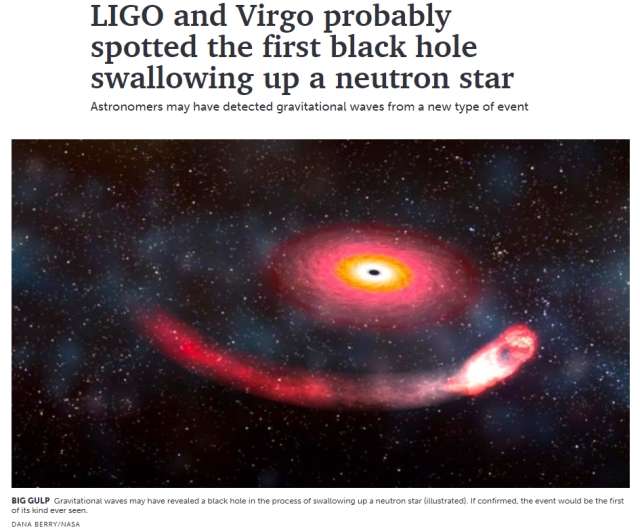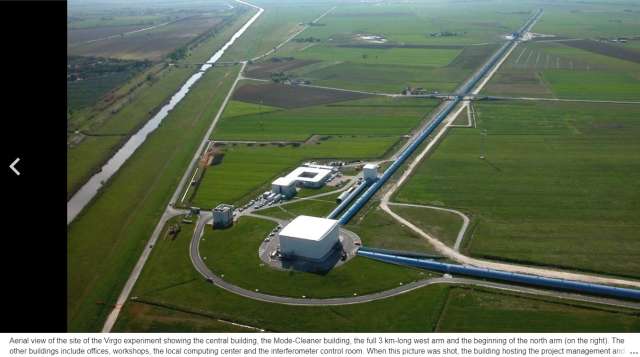
By Emily Conover
AUGUST 15, 2019 AT 6:06 PM
Shudders in the cosmos have revealed what’s likely the sad end of a neutron star — getting swallowed by a black hole.
If confirmed, it would be the first solid detection of this source of gravitational waves, revealing a type of cataclysm never before spotted. Researchers from the LIGO and Virgo gravitational wave observatories reported the candidate event, which was detected August 14, in a public database used by astronomers.
Scientists are still analyzing the data to verify what created the gravitational waves, which are tiny vibrations in spacetime caused by massive, accelerating objects. But one thing seems fairly certain: “Something has occurred out there in the sky,” says physicist Daniel Holz of the University of Chicago, a member of LIGO. “So far, it doesn’t obviously look like anything we’ve detected with high confidence before.”
LIGO and Virgo previously have picked up gravitational waves from pairs of merging black holes and from colliding neutron stars, which are extremely dense collapsed stars (SN: 1/19/19, p. 10). In April, scientists saw tentative hints of a rendezvous between a black hole and neutron star, but the signal was weak and could have been a false alarm (SN Online: 5/2/19).
This new discovery offers much more solid evidence: The detection was so clear that it’s considered very unlikely to be a false alarm. The researchers estimate that the run-in between the two objects occurred around 900 million light-years away, and within an area about 23 square degrees across the sky. (For comparison, the moon is about half a degree across.) Astronomers have since been peering at that region with their telescopes, looking for any light that may have been emitted in the merger. Such light could have been released if the neutron star were torn apart by the black hole before being gulped within its depths.
Further study of the encounter could help reveal new secrets about some of the universe’s most mysterious objects. But the potential detection is exciting on its own, Holz says. “The first of anything is always really fascinating.”
A quick recap of some key notions:
a.) A neutron star:
If a star right before going Supernova still has a mass of between ten and twenty solar masses, the core that remains after the explosion is a neutron star. Whilst weighing around 1.4 solar masses, its diameter is only about 20 kilometers, which means that one spoonful of that neutron star weighs about 1 billion tonnes!
b.) A Black Hole:
If the mass of the star before going Supernova was over 20 solar masses the remaining core may exceed 5 M☉, and from about 3–4 M☉ (the Tolman–Oppenheimer–Volkoff limit), the degeneracy pressure of neutrons which otherwise stops neutron stars from imploding into themselves, is now insufficient to stop further collapse. A black hole is born.
While we are at it, fun quiz: what would happen if you fell into a black hole?
c.) LIGO:
LIGO stands for Laser Interferometer Gravitational-Wave Observatory. It is a large-scale physics experiment involving two observatories to detect cosmic gravitational waves and to develop gravitational-wave observations as an astronomical tool. Laser interferometry is used to detect gravitational waves. LIGO can detect a change in the 4 km mirror spacing of less than a ten-thousandth the charge diameter of a proton. There is an observatory in Hanford, Washington and one in Livingston, Texas.
d.) Virgo:
Virgo is LIGO's European couterpart, a large interferometer designed to detect gravitational waves. Virgo is a Michelson interferometer is isolated from external disturbances: its mirrors and instrumentation are suspended and its laser beam operates in a vacuum. The instrument's two arms are three kilometres long and located in Santo Stefano a Macerata, near Pisa, Italy. Godammit! We spent our summer holiday in Tuscany and of course we had to go see Pisa and its slanted tower and duomo and baptisterio. If I had known that Virgo was just around the corner, I definitely would have taken a look!

I can't for the love of God fathom what kind of a big gulp a black hole gobbling up a neutron star must give. Lucky are those with the smarts and the tools to explore these inimaginable phenomena.
MFBB.